How China turned its desert into a fruit growing oasis

Wolfberries growing in the desert. China’s Ningxia province has embarked on planting trees to curb desertification, using Yellow River for irrigation purposes. Photo by M. Vuchiri.
What you need to know:
Innovative solutions spearheaded by a province in China, have turned its fortunes around, thanks to irrigation and tree planting in the desert area.
For a province that has vast tracts of desert land and is ranked third in development among China’s five autonomous provinces, Ningxia Hui Autonomous Region, located in northwest China, has registered remarkable progress. Statistics from China’s premier website www.china.org.cn indicate that Ningxia is the province with the third smallest GDP in China, with its neighbours, Inner Mongolia and Shaanxi, classified as the strongest emerging provincial economies in that country. And yet for a casual Ugandan visitor, Ningxia’s capital, Yinchuan, would be one of the most developed and well planned metropolises with very good road network- compared to Kampala, of course.
As a largely arid region, Ningxia’s transformation is mainly attributed to the province being China’s principle supplier of wolfberries— a fruit this region regards a treasure, accounting for 42 per cent of the entire nation’s total wolfberry production. At the Research Institute of Lycium Barbarum in Yinchuan, there are large plantations of wolfberries and grapes, grown mainly for medicinal purposes and producing wine.
Mr Wang Ling of Ningxia’s Department of Agriculture, Forestry and Animal Husbandry, says the region’s development path is hugely determined by agriculture.
“The Yellow River (for irrigation purposes) is very important for us, for our plants and for our animals,” says Ling, adding that the achievements they have so far made would not have been possible without sustained anti-desertification campaigns such as tree planting.
One such project is a paper industry base whose raw materials come from a vast tree-planting scheme in a desert area in Zhongwei City. Started in 2001, the Meili Group that manages this project has been able, in the last 11 years, to turn large portions of this former desert into an expansive Greenland, supported by constant irrigation from the Yellow River.
Replanting the desert
While the trees have worked wonders for the environment, it also supplies, upon maturity, raw materials for the paper industry. Organic materials from the same paper industry are in turn used to fertilise the tree plantations. It is, according to Wang Ting, Deputy General Manager of Meili Forestry Developing Company, a-win-win situation. “The forests revive the environment and supply raw materials; the paper industry provides fertilisers,” he says.
This is by no means an easy venture. Though the land was given by government, with some subsidies and loans extended to the group, it takes a lot of work and dedication to carry out a project of this magnitude, moreover in a desert. There still remain significant challenges: Inadequate water for irrigation, sand storms, insects and pests. The overall goal of eventually turning this desert into oasis, however, overrides these challenges. Already, the project has improved the local environment and, according to Mr Ting, if they can encourage more locals to plant trees, this will positively impact the environment as well as improve the economic conditions of the people. This forestry development venture is a classic case of a region that is not, like Uganda, gifted by nature, but has devised ways of making good use of their desert land. On the contrary, in Uganda where we are naturally rich in vegetation, our environment management practices are quite poor. According to projections, Uganda could lose its forest cover in less than 40 years if action is not taken to reverse poor environment management. A 2008 Environment Report warned of the dire consequences of forest cover degradation, especially disappearance of wetlands and water bodies. Four years later, Uganda’s state of the environment remains poor, if not worse.
Innovative solutions
Ningxia, on the other hand, has used innovative ways to develop their agricultural output and supply of dairy products (dairy farms depend mainly on corn that is planted on a large scale partly because they want to preserve their grassland from being destroyed by grazing cattle). According to Mr Kang Zhanping, the Deputy Director General of the Publicity Department and Director of External Publicity Office, Ningxia Hui Autonomous Region, wolfberries are not Ningxia’s only competitive edge. The region’s agriculture success lies primarily in the ancient irrigational system from the famous Yellow River.
The Helan Horticulture Industry Park, for instance, produces a rich variety of crops using hydroponics method- a process where plants are grown without soil and necessary food elements mixed with the water used for irrigation. Through this method, officials at this industrial park say they are able to produce a wide variety of crops in large quantities on limited space. That is why Ningxia is able to export vegetables and fruits to mainly Hong Kong among other countries as well as sweet potatoes to the Middle East and other Arab countries.
This agricultural development can be partly attributed to the region’s agriculture academy that carries out research in agriculture technologies for development of crops such as wheat, corn, rice as well as fruits like the famous wolfberries.




